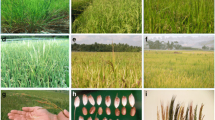Abstract
Genotype × environment interaction effects can be exploited by breeding for specific adaptation to well-defined subregions within a target region. Previous work showed that genotype × location interaction for dry matter (DM) yield of lucerne (Medicago sativa L. subsp. sativa) cultivars in northern Italy is large and associated with soil type and level of summer drought stress of locations, suggesting the presence of two contrasting subregions. Thirteen farm landraces collected across the region and four control varieties were evaluated for DM yield in four artificial environments created at one site by the factorial combination of soil type (sandy loam or silty clay) and drought stress level (almost nil or high) for: (1) exploring the possibility to reproduce in artificial environments the adaptation patterns occurring across the region; (2) investigating the adaptation pattern of landraces and its relationship with environmental factors at collecting sites; and (3) providing a preliminary comparison of wide- versus specific-adaptation strategies based on yield gains predicted from selection of populations. Different soils filled large (24.0×1.6×0.8-m deep), bottomless containers in concrete. Water amounts were controlled by irrigation under a moving rain shelter. Cultivars varied largely for adaptation pattern across the artificial environments, mainly due to cultivar × stress interaction. Better response to stress conditions of landraces was closely associated with the level of summer drought at collecting sites (r=0.82), highlighting the importance of evolutionary adaptation. The additive main effects and multiplicative interaction-modelled responses of control cultivars successfully reproduced those observed across locations, candidating the artificial environments as a cheaper alternative to more selection locations when breeding for wide or specific adaptation. The latter implied about 40–50% greater estimated gains relative to breeding for wide adaptation.



Similar content being viewed by others
References
Annicchiarico P (1992) Cultivar adaptation and recommendation from alfalfa trials in northern Italy. J Genet Breed 46:269–278
Annicchiarico P (1997) Additive main effects and multiplicative interaction (AMMI) analysis of genotype-location interaction in variety trials repeated over years. Theor Appl Genet 94:1072–1077
Annicchiarico P (2000) Variety × location interaction and its implications on breeding of lucerne: a case study. In: Veronesi F, Rosellini D (eds) Lucerne and medics for the XXI century. University of Perugia, Perugia, pp 35–43
Annicchiarico P (2002a) Genotype × environment interactions: challenges and opportunities for plant breeding and cultivar recommendations. FAO plant production protection paper 174. FAO, Rome
Annicchiarico P (2002b) Defining adaptation strategies and yield stability targets in breeding programmes. In: Kang MS (ed) Quantitative genetics, genomics and plant breeding. CABI, Wallingford, pp 365–383
Annicchiarico P, Mariani G (1996) Prediction of adaptability and yield stability of durum wheat genotypes from yield response in normal and artificially drought-stressed conditions. Field Crops Res 46:71–80
Basford KE, Cooper M (1998) Genotype × environment interactions and some considerations of their implications for wheat breeding in Australia. Aust J Agric Res 49:153–174
Basford KE, Federer WT, DeLacy IH (2004) Mixed model formulation for multi-environment trials. Agron J 96:143–147
Bramel-Cox PJ, Barker T, Zavala-Garcia F, Eastin JD (1991) Selection and testing environments for improved performance under reduced-input conditions. In: Sleper D, Bramel-Cox PJ, Barker T (eds) Plant breeding and sustainable agriculture: considerations for objectives and methods. CSSA Special Publication, vol 18. ASA, CSSA, SSSA, Madison, pp 29–56
Casler MD, Undersander DJ (2000) Forage yield precision, experimental design, and cultivar mean separation for alfalfa cultivar trials. Agron J 92:1064–1071
Ceccarelli S (1989). Wide adaptation: how wide? Euphytica 40:197–205
Ceccarelli S (1996) Positive interpretation of genotype by environment interaction in relation to sustainability and biodiversity. In: Cooper M, Hammer GL (eds) Plant adaptation and crop improvement. CABI, Wallingford, pp 467–486
Ceccarelli S, Grando S, Impiglia A (1998) Choice of selection strategy in breeding barley for stress environments. Euphytica 103:307–318
Cooper M, Woodruff DR, Eisemann RL, Brennan PS, DeLacy IH (1995) A selection strategy to accommodate genotype-by-environment interaction for grain yield of wheat: managed-environments for selection among genotypes. Theor Appl Genet 90:492–502
Dal Monte G, Perini L, Brunetti A (1995) Indici agroclimatici. Ufficio Centrale Ecologia Agraria, Rome
Falconer DS (1989) Introduction to quantitative genetics, 3rd edn. Longman, New York
FAO (1990) Guidelines for soil profile description. FAO, Rome
Federer WT, Scully BT (1993) A parsimonious statistical design and breeding procedure for evaluating and selecting desirable characteristics over environments. Theor Appl Genet 86:612–620
Fischer KS (1996) Research approaches for variable rainfed system. Thinking globally, acting locally. In: Cooper M, Hammer GL (eds) Plant adaptation and crop improvement. CABI, Wallingford, pp 25–35
Gauch HG (1992) Statistical analysis of regional yield trials: AMMI analysis of factorial designs. Elsevier, Amsterdam
Gauch HG, Zobel RW (1997) Identifying mega-environments and targeting genotypes. Crop Sci 37:311–326
Julier B (1996) Traditional seed maintenance and origins of the French lucerne landraces. Euphytica 92:353–357
Muñoz P, Voltas J, Araus JL, Igartua E, Romagosa I (1998) Changes over time in the adaptation of barley releases in north-eastern Spain. Plant Breed 117:531–535
van Oosterom EJ, Bidinger FR, Weltzien ER (2003) A yield architecture framework to explain adaptation of pearl millet to environmental stress. Field Crops Res 80:33–56
Piepho HP (1995) Robustness of statistical tests for multiplicative terms in the additive main effects and multiplicative interaction model for cultivar trials. Theor Appl Genet 90:438–443
Russi L, Falcinelli M (1997) Characterization and agronomic value of Italian landraces of lucerne (Medicago sativa). J Agric Sci (Camb) 129:267–277
Simmonds NW (1991) Selection for local adaptation in a plant breeding programme. Theor Appl Genet 82:363–367
Wade LJ, McLaren CG, Samson BK, Regmi KR, Sarkarung S (1996) The importance of environmental characterization for understanding genotype by environment interactions. In: Cooper M, Hammer GL (eds) Plant adaptation and crop improvement. CABI, Wallingford, pp 549–561
Acknowledgements
We gratefully acknowledge S. Proietti for excellent technical assistance.
Author information
Authors and Affiliations
Corresponding author
Additional information
Communicated by H.C. Becker
Rights and permissions
About this article
Cite this article
Annicchiarico, P., Piano, E. Use of artificial environments to reproduce and exploit genotype × location interaction for lucerne in northern Italy. Theor Appl Genet 110, 219–227 (2005). https://doi.org/10.1007/s00122-004-1811-9
Received:
Accepted:
Published:
Issue Date:
DOI: https://doi.org/10.1007/s00122-004-1811-9




